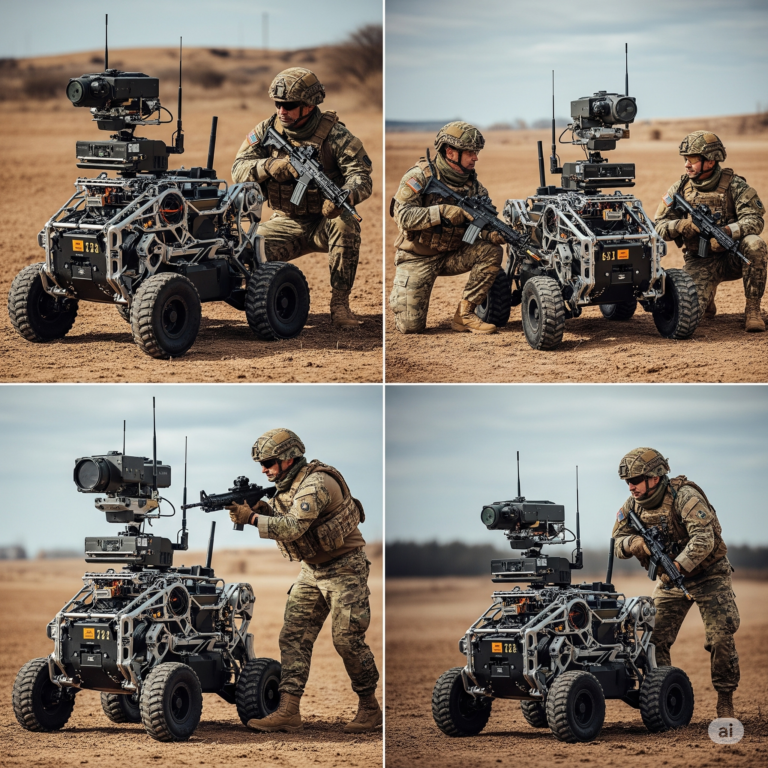- 📰 Introduction: AI Military Robots Are Being Trained for War — Should We Be Worried?
- 🛠️ How AI Military Robots Are Being Trained
- ⚠️ The Risks of Using AI in Military Robots
- 🌐 Global Military Interest in AI-Powered Robots
- ⚖️ Legal and Ethical Dilemmas
- 🔮 What the Future Looks Like
- ✅ Conclusion: AI Military Robots — A Technological Leap or a Step Too Far?
📰 Introduction: AI Military Robots Are Being Trained for War — Should We Be Worried?
In 2025, the rise of AI military robots is no longer science fiction. Militaries around the world — including the U.S., China, and several NATO countries — are actively developing and testing autonomous robotic systems for combat missions. These machines can navigate terrain, identify targets, and even make life-or-death decisions with minimal human input. But what are the ethical and security risks behind this technology?
🛠️ How AI Military Robots Are Being Trained
🤖 From Surveillance to Combat
While drones and robotic dogs are already common in defense, the next generation of Artificial Intelligence military robots is being trained to handle full missions — including recon, rescue, and offensive strikes — using real-time learning and simulation.
🧠 Deep Learning Meets Battlefield Data
Modern AI models ingest massive datasets from past conflicts, satellite images, and live sensor data to train for high-pressure environments. Some systems even learn from human soldiers’ decision patterns.
⚠️ The Risks of Using AI in Military Robots
🔫 Who Decides When to Shoot?
One of the biggest concerns is autonomous weapons making lethal decisions without human confirmation. Critics warn this could lead to unintended escalations or civilian casualties.
🔁 Risk of Malfunction or Hacking
AI military robots rely on networks and software — making them vulnerable to malfunctions, signal jamming, or cyberattacks, especially from sophisticated adversaries.
🌐 Global Military Interest in AI-Powered Robots
🇺🇸 U.S. and NATO Projects
The U.S. Department of Defense is investing heavily in AI autonomy research, including swarms of robotic drones and underwater systems. NATO allies are testing similar tech in joint exercises.
🇨🇳 China’s AI Ambitions
China is rapidly advancing in robotic warfare, integrating AI into land vehicles, drones, and even robotic exosuits. Analysts say China aims to be a leader in Artificial Intelligence military strategy by 2030.
⚖️ Legal and Ethical Dilemmas
📜 No Global Agreement Yet
Unlike nuclear weapons, there is no international treaty banning or regulating the use of Artificial Intelligence military robots. The UN has debated the topic, but progress is slow and non-binding.
👥 Human Rights Groups Raise Alarms
Organizations like Human Rights Watch argue that delegating lethal force to machines is morally unacceptable, calling for a global ban on autonomous weapons.
🔮 What the Future Looks Like
As militaries continue testing and refining Artificial Intelligence military robots, we may see more autonomous systems deployed in surveillance, logistics, and low-risk combat support roles. But full autonomy in warfare remains a deeply divisive and dangerous frontier.
✅ Conclusion: AI Military Robots — A Technological Leap or a Step Too Far?
The development of AI military robots marks a turning point in modern warfare. While they promise speed, efficiency, and fewer human casualties, they also raise urgent questions about control, accountability, and global stability. The world must decide — before machines start making those decisions for us.


